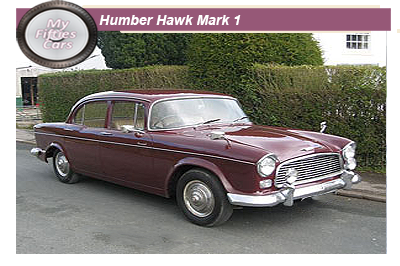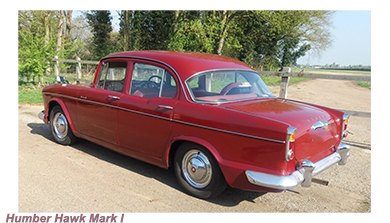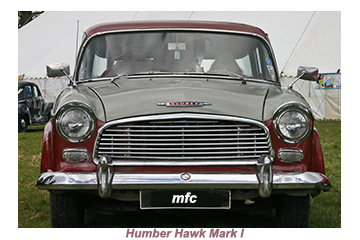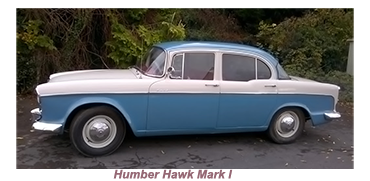 As the end of the Fifties began to approach, the suffix numbers for the Humber Hawk Series were starting to cause some confusion, as each model was more or less an exact continuation of it predecessor.
As the end of the Fifties began to approach, the suffix numbers for the Humber Hawk Series were starting to cause some confusion, as each model was more or less an exact continuation of it predecessor.
 In 1957 the design department at Humber came up with completely new redesign, which the inventively named the Humber Hawk Series 1.
In their drive to develop a new generation of big Humbers to take them into the Sixties, Rootes commissioned an all-new unit-construction shell,
For more than a year, after its release in 1957, the Series I-Hawk would double for duty as the basis not just for a new generation of Hawks but also as a new Super Snipe, , an example of bandge engineering that was beginning to plague the UK car industry during the late Fifties.
Humber indignatly claimed that the launch of these almost identical models was that the company found themselves way behind schedule with the release of the next generation of Super Snipes.
Never slow at blowing their own trumpet, Humber placarded the Series I-Hawk as the largest car in production in the UK at that time, although that record would not remain intact for too long, with BMC's C-Series "Farina" range of cars released not so long after.
The Humber Hawk Series I’s shell was a sturdy all-steel four-door saloon, with distinctive wraparound front and rear windows.
Soon after the release of the saloon, a five-door estate car followed, with the first models released in October 1957.
In 1957 the design department at Humber came up with completely new redesign, which the inventively named the Humber Hawk Series 1.
In their drive to develop a new generation of big Humbers to take them into the Sixties, Rootes commissioned an all-new unit-construction shell,
For more than a year, after its release in 1957, the Series I-Hawk would double for duty as the basis not just for a new generation of Hawks but also as a new Super Snipe, , an example of bandge engineering that was beginning to plague the UK car industry during the late Fifties.
Humber indignatly claimed that the launch of these almost identical models was that the company found themselves way behind schedule with the release of the next generation of Super Snipes.
Never slow at blowing their own trumpet, Humber placarded the Series I-Hawk as the largest car in production in the UK at that time, although that record would not remain intact for too long, with BMC's C-Series "Farina" range of cars released not so long after.
The Humber Hawk Series I’s shell was a sturdy all-steel four-door saloon, with distinctive wraparound front and rear windows.
Soon after the release of the saloon, a five-door estate car followed, with the first models released in October 1957.

 In both the saloon and estate version of the Mark I Hawks, the result was big, spacious car, with a distinct Mid- Atlantic look.
The Mark I-Hawk engine was a 2267cc overhead-lye unit capable of generating rated at 73bhp carried forward from the previous Hawk, which mated to a four-speed column change gearbox, although with no synchromesh on first. Laycock overdrive was optional, as was (until 1962) Borg Warner automatic transmission, while Drum brakes were standard.
In both the saloon and estate version of the Mark I Hawks, the result was big, spacious car, with a distinct Mid- Atlantic look.
The Mark I-Hawk engine was a 2267cc overhead-lye unit capable of generating rated at 73bhp carried forward from the previous Hawk, which mated to a four-speed column change gearbox, although with no synchromesh on first. Laycock overdrive was optional, as was (until 1962) Borg Warner automatic transmission, while Drum brakes were standard.
 >As the end of the Fifties approached, Rootes managed to squeeze in another update of the Hawk - the Series IA that came on the market in October 1959. The only update worth noting was different internal gear ratios.
The first major update of the Sixties came in the summer of 1962, with the arrival of the Series III which again included a saloon and estate version. For the private hire sector or top-level businesspeople, a limousine version was also available but by special order only.
Externally the only update that could be readily discerned was the Hawk's completely revamped rear window, with new windscreen surround and guttering on the front.
>As the end of the Fifties approached, Rootes managed to squeeze in another update of the Hawk - the Series IA that came on the market in October 1959. The only update worth noting was different internal gear ratios.
The first major update of the Sixties came in the summer of 1962, with the arrival of the Series III which again included a saloon and estate version. For the private hire sector or top-level businesspeople, a limousine version was also available but by special order only.
Externally the only update that could be readily discerned was the Hawk's completely revamped rear window, with new windscreen surround and guttering on the front.
 Mechanically the new Hawk came with overdrive, although only available on third and top gears. In respect to its " gas guzzling" abilities, the new Mark Ills shipped with a larger petrol tank, capable of holding 16 gallons ( 60 litres) instead of the previous 12.5 gallons ( 47.3 litres).
vWith the cost of gasoline being around the equivalent of thirty pence a gallon ( 45 cents) petrol consumption was far from an issue during the Sixties.
Mechanically the new Hawk came with overdrive, although only available on third and top gears. In respect to its " gas guzzling" abilities, the new Mark Ills shipped with a larger petrol tank, capable of holding 16 gallons ( 60 litres) instead of the previous 12.5 gallons ( 47.3 litres).
vWith the cost of gasoline being around the equivalent of thirty pence a gallon ( 45 cents) petrol consumption was far from an issue during the Sixties.
 During the rest of the Humber Hawk production, which ended in 1968, there was Series 1A in 1959, Series 2 in 1960 (disc brakes), Series 3 in 1962 slight body alterations, Series 4 for 1964 with more bodywork alterations with the final model being the Series 6A introduced in 1964.
The Mark I was the best selling version of all the Hawks with just over 15,000 sold in the close to two years that this model was in production. Overall, the Mark I- VI series of Humber Hawks, in all of its versions in the seven years that it was in production sold a total of 41,000 cars.
During the rest of the Humber Hawk production, which ended in 1968, there was Series 1A in 1959, Series 2 in 1960 (disc brakes), Series 3 in 1962 slight body alterations, Series 4 for 1964 with more bodywork alterations with the final model being the Series 6A introduced in 1964.
The Mark I was the best selling version of all the Hawks with just over 15,000 sold in the close to two years that this model was in production. Overall, the Mark I- VI series of Humber Hawks, in all of its versions in the seven years that it was in production sold a total of 41,000 cars.
Got a question, a comment, a suggestion or an offer??? - FEEL FREE TO CONTACT US ANYTIME!!
Take me back to the Home Page
All the history of the great UK and European cars of the Fifties and Sixties and the people that produced them as well as how to acquire, restore and maintain a classic car.